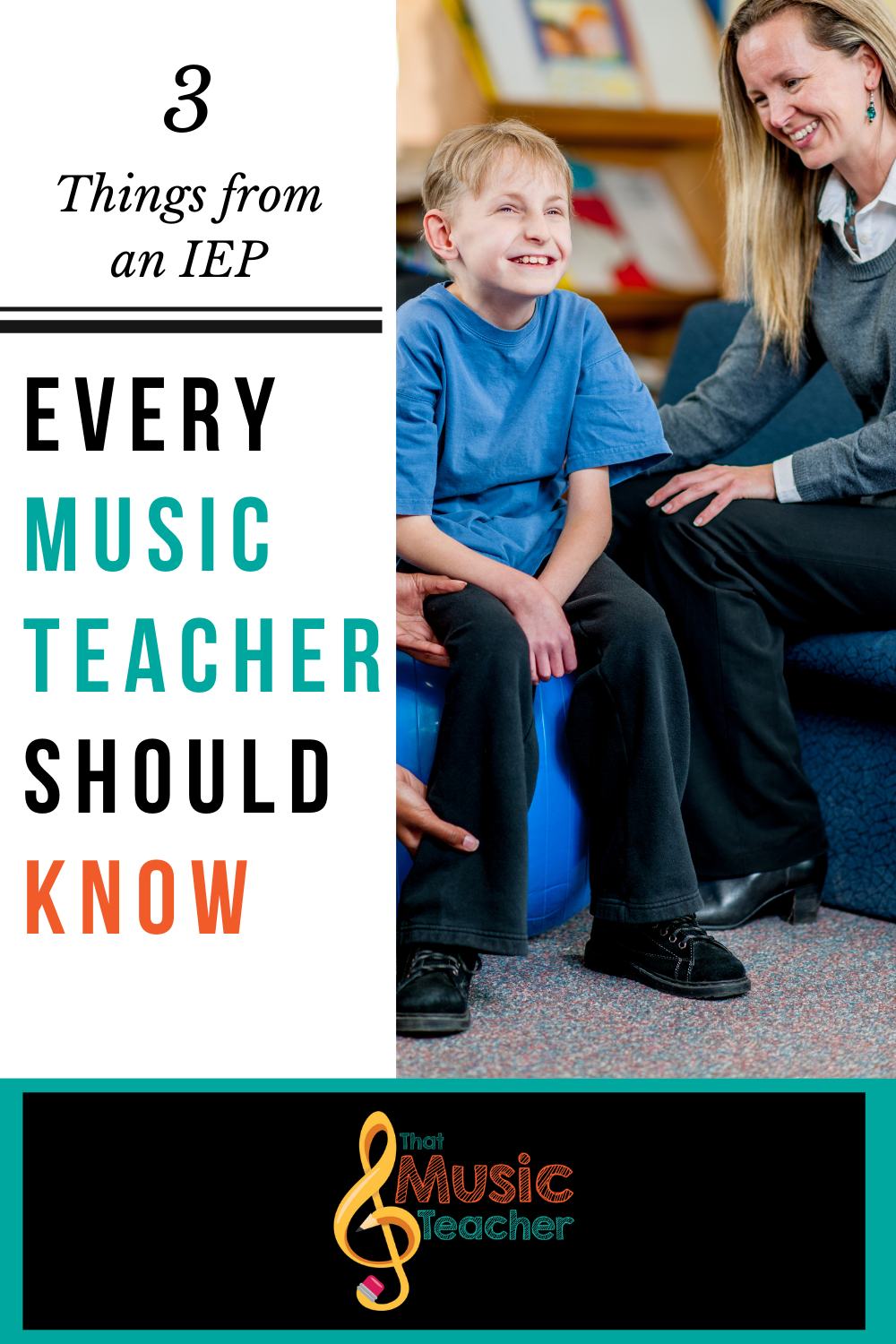
Three Things from an IEP that Every Music Teacher Should Know
Dec 08, 2020When it comes to IEPs, it can be overwhelming for the non-special education teachers to think about. Heck, it’s even overwhelming at times as the seasoned special education teacher, too! What is an SDI? Why should I look at their goals? What is a PBSP?! All these acronyms can be too much to think about, especially when we have our own music curriculum and grading to think of. You know what? It’s the special educator’s job to worry about that stuff. I don’t really need to “modify.” I will just group the special education kids together and will refer to their teacher if they are ever “problems.” Right?
WRONG.
If you ever had this line of thinking in the past, don’t worry. It doesn’t make you a bad teacher. You were probably never informed (or it was never stressed to you how important it is) that us music teachers are just as legally obligated to adhere to the IEP as the case manager or special educator teacher themselves. We need to be aware of ALL the components of an IEP, but, to help you with feeling less overwhelmed, I am here to tell you that there are three components that are the most important for you to be aware of. Again, this is not to say that you shouldn’t become familiar with ALL parts of the IEP, but the following three components should be where you go first when looking through (or asking the case manager about) an IEP.
SDI’s (AKA, Specially Designed Instruction)
Specially Designed Instruction (SDI’s) is the part of the IEP that is (arguably) most important for any general or ‘regular’ education teacher to pay attention to (aka, you!) This is where the student’s accommodations and curricular modifications are found. This will list every component that the student will need to be successful in the general and special education classrooms. It’s a requirement, by law, that SDI’s are followed by all teachers and therapists who interact with the student in an academic setting.
As a music teacher, this would be the first component I would orient myself with for the student. Does the student need text highlighted to better read or comprehend materials? Does the student have a visual impairment, and require high-contrast materials or braille? Does the student need movement breaks to help prevent unwanted behaviors? All of these questions are the questions that would be answered in the SDI section of the IEP. Not only is this legally required for you to adhere to, but it will also help these students be successful in your classroom and full participants in the music curriculum. You may think to yourself, “Wow, that is a lot of work,” but, with the help of the special education teacher, having these modifications will not only help this student, but can potentially help other students now and in the future. Here’s why.
Do you ever find yourself using the handrail, or ramp, or elevator in a building? You may not need these things to get around the building, but they are functional for you as well, correct? That is sort of like modifications within the general classroom. They might not be necessary for every student, but maybe Suzy also benefits from highlighted text as well. Even though she doesn’t have an IEP, it might help Suzy learn better, too.
So, the moral of the story is that SDI’s benefit not only the child who’s IEP they are apart of, but all students who are in your class.
Positive Behavior Support Plan (PBSP)
A Positive Behavior Support Plan (PBSP) provides strategies and supports to help students who have been found, by the IEP team through a systematic assessment, to need a behavior plan. As one of the general education teachers who services a student with a PBSP, it will definitely benefit you to read this plan prior to teaching them. There are a few reasons why this is crucial for a successful classroom environment:
-
There is critical information in the PBSP to help you mitigate and stop behaviors before they even start.
Now you could, of course, ask their special education teacher or case manager to give you the spark notes version of the PBSP, but you could be missing vital information. You might miss the WHY behind the behaviors. Often times, the special education teacher will tell you WHAT to do, not WHY.
For instance, the teacher might tell you, “Benny benefits from using a timer, and every 15 minutes he has with good behavior he gets to go for a 2 minute walk break.” This is great to know, but do you know WHY Benny needs a break? Are some activities overwhelming for him, and he needs to escape? Is he overstimulated? What if an activity upsets Benny, and he doesn’t make it through his 15 minutes with expected behavior? What if he shouts, throws something, or starts to disrupt the class? This is why knowing the “why” behind behaviors can help you prevent Benny from virtually ever having behaviors in your class. This why is embedded into the PBSP.
2. It will detail everything you need to support the student in their behavior goals.
Does this student also follow a behavior chart? Does he participate in a token economy where he gets a reward at the end of the day, or the option to “cash in” his points? If you know this, you can give this student reminders throughout the class to remind him what he is working for. “Benny, you are doing great. Remember what you are working for. You can cash out today and get __________.” This can be a great motivator for a student who may be teetering during your class.
3. It gives you the tools to handle unexpected behaviors when they occur.
Let’s face it. We will most likely encounter behaviors from students who have PBSPs. However, if we are familiar with out to mitigate these behaviors, it will help them from (potentially) becoming bigger (or longer, or more) behaviors. If a student is engaging in a behavior to seek attention, the PBSP will tell us exactly how to react to a student doing this, such as “planned ignoring.” If a student is visibly upset and/or throwing objects, the PBSP will tell us the type of language we should use and how we should react to this, (such as using a calm tone, low voice, using a “supportive stance,” etc.)
The PBSP is something that is worth the thorough read through on your end. It can make or break your year as the music teacher with this student. By going off of hearsay or what former teachers will tell you about this student’s behavior in the classroom, you are ignoring the systematically collected data on this student and the proven supports that work for them.
Goals and Objectives:
Last, but not least, the “bread and butter” of the IEP, are the goal and objectives. These, while one of the most important aspects to the special education teacher, therapists, and/or case manager of the IEP, are not the most important aspects for us general education teachers. That’s not to say goals and objectives aren’t important for us to know (which is why I have included them this blog post!) but they are not as important for us to understand as SDI’s or the PBSP. Here’s why.
-
Goals and objectives usually will not pertain to your classroom domain.
Now, this is not to say that this will never happen (see below). However, many student’s goals and objectives pertain to other academic areas such as reading, writing, math, and social skills. They may also pertain to speech, occupational, or physical therapy goals. The data that are collected for these goals is most likely done in the special education classroom or by a therapist.
2. You MAY be responsible for collecting data or providing feedback to the special education teacher for an IEP student if data is collected ever in your classroom.
Remember why it was so important for us to be familiar with the PBSP? Well, another reason why it is so important to be familiar with this is that, within the PBSP is a behavior goal that you may have to report on or provide information on if it is collected in your classroom. Typically, a student with a PBSP will have a teacher aide or paraprofessional with them during their general education classes; and this person will be collecting the data on the student’s behavior goals. However, if you are asked to provide feedback or input on an IEP, it may be good for you to be aware of any goals where data is collected during your class time. You can offer any insights or observations you may have about this student in their progress towards their goal during your class.
Concluding Thoughts
IEPs can be scary for us general education teachers. However, it is simply a document that helps to ensure students with different learning needs have these needs met. It ensures they have access to the same education that other students have access to. It allows us to differentiate learning to meet these needs to help them be as successful as they can be in our classroom. And, at the end of the day, this is what we want for all of our students. By being aware of SDI’s, PBSPs, and Goals and Objectives, we are further committing ourselves to providing the best education that we can to ALL students.
What are some questions you have about IEP’s? Let us know in the comments!
Be sure to get your free copy of “5 Ways to Better Serve Students with Exceptional Needs”
This article was submitted by Lauren Marcinkowski contributing author for ThatMusicTeacher.com. Interested in becoming a contributing author? Email resume and writing sample to [email protected]

Don't miss a beat!
New moves, motivation, and classes delivered to your inbox.
We hate SPAM. We will never sell your information, for any reason.

